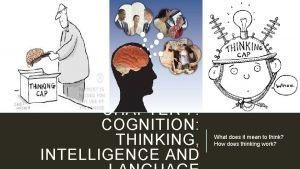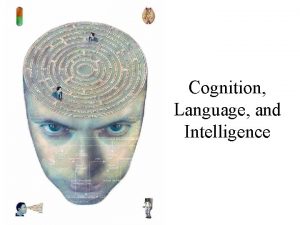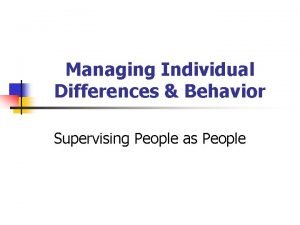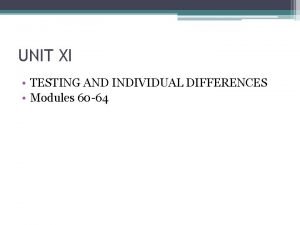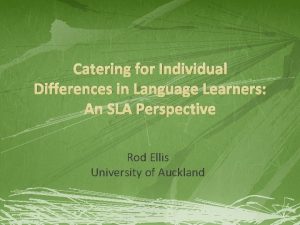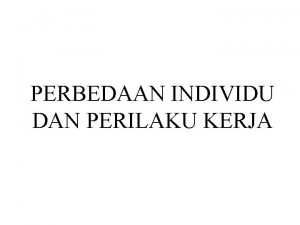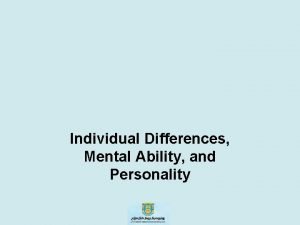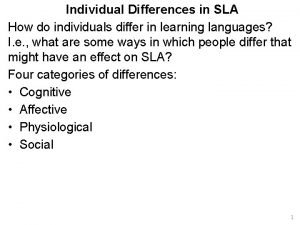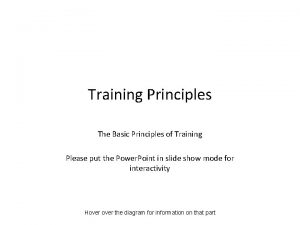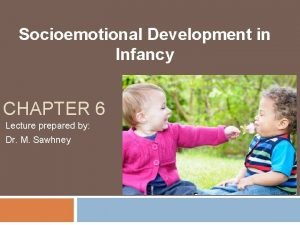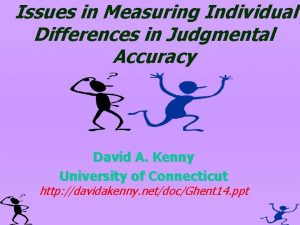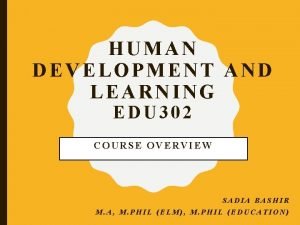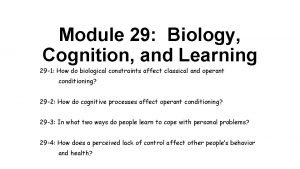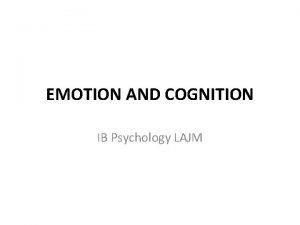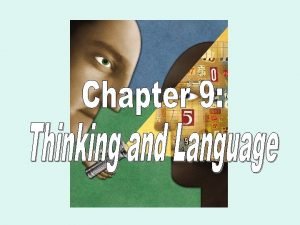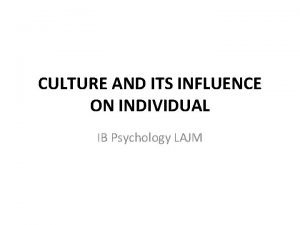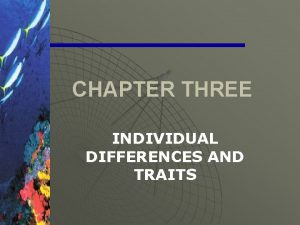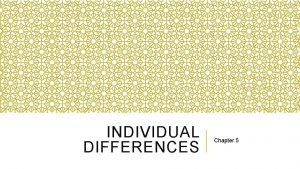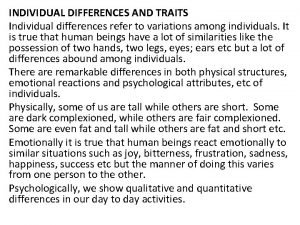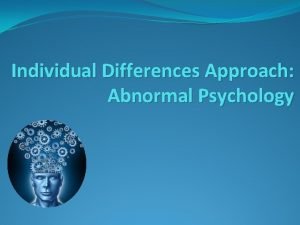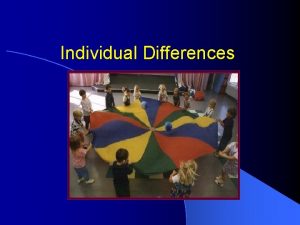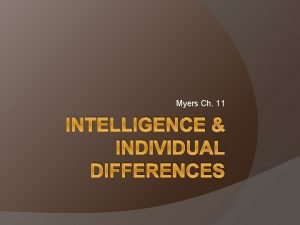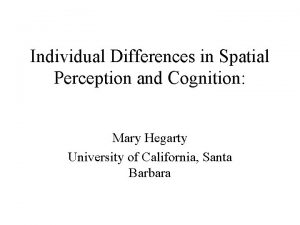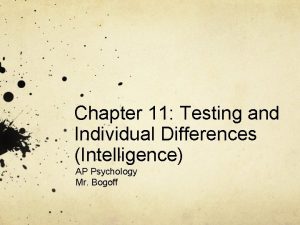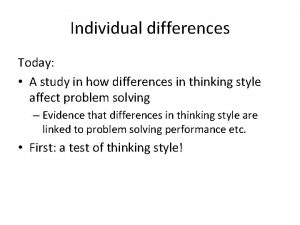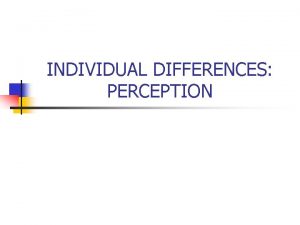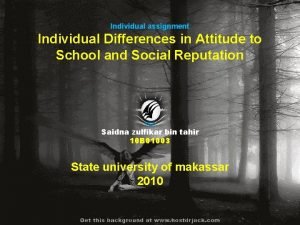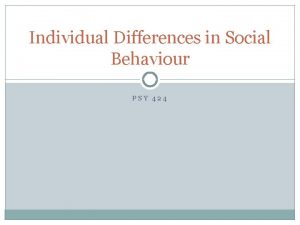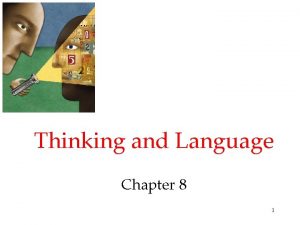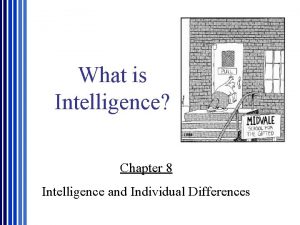Chapter 9 Intelligence and Individual Differences in Cognition























- Slides: 23

Chapter 9: Intelligence and Individual Differences in Cognition Module 9. 1 What is Intelligence? Module 9. 2 Measuring Intelligence Module 9. 3 Special Children, Special Needs Children and Their Development, 3/e by Robert Kail

9. 1 What is Intelligence? Psychometric Theories Gardner’s Theory of Multiple Intelligences Sternberg’s Triarchic Theory

9. 1 Psychometric Theories • Use patterns of test performance as starting point • Test scores provide evidence for general intelligence (g) and specific intelligences (e. g. , perceptual speed, word comprehension) • Hierarchical theories are a compromise between general and specific theories

Hierarchical View of Intelligence 9. 1: Psychometric Theories

9. 1 Gardner’s Theory of Multiple Intelligences • Instead of using test scores, draws upon research in child development, braindamaged adults, and exceptional talent • Proposes 7 intelligences: linguistic, logicalmathematical, spatial, musical, bodilykinesthetic, interpersonal, intrapersonal • Gardner believed that schools should foster all intelligences

9. 1 Sternberg’s Triarchic Theory • Contextual subtheory--intelligence involves skillful adaptation to a specific environment • Experiential subtheory--on novel tasks, intelligence is shown by readily applying pertinent knowledge; on familiar tasks, by solving them automatically • Componential subtheory--any intelligent act consists of cognitive components

Sternberg’s Triarchic Theory 9. 1: Sternberg’s Triarchic Theory

9. 2 Measuring Intelligence Binet and the Development of Intelligence Testing Do Tests Work? Hereditary and Environmental Factors Impact of Ethnicity and Socioeconomic Status

9. 2 Binet and the Development of Intelligence Testing • Binet used mental age to distinguish “bright” from “dull” children • Led to the Stanford-Binet which gives a single IQ score; average = 100 • WISC, devised in the 1930 s, gives verbal and performance IQ scores and a combination of the two scores

Distribution of IQ Scores 9. 2: Binet and the Development of Intelligence Testing

Sample Items from WISC-II 9. 2: Binet and the Development of Intelligence Testing

9. 2 Do Tests Work? • Are they reliable? In the short term, yes. In the longer term, less so. • Infant tests do not reliably predict adult IQ, but scores obtained in childhood do • Are they valid? Yes, tests are good predictors of success in school and the workplace, particularly for more complex jobs • Validity can be increased with dynamic testing (measures learning potential)

Correlation Between Childhood and Adult IQ 9. 2: Do Tests Work?

9. 2 Hereditary and Environmental Factors • Effects of heredity shown in family studies • Heredity also influences patterns of intellectual development (twins, adoptees) • Effects of environment shown in studies of home environments (children with high test scores come from well-organized homes), historical change in IQ scores, and intervention programs

Correlations of IQ for Family Members 9. 2: Hereditary and Environmental Factors

9. 2 Impact of Ethnicity and Socioeconomic Status • Asian Americans have highest scores followed by European Americans, Hispanic Americans, and African Americans • Group differences reduced when compare groups of similar economic status • Culture-fair intelligence tests reduce the differences but don’t eliminate them • Stereotype threat: knowledge of stereotypes leads to anxiety and reduced performance • Test-taking styles must be considered, too

Culture-fair Test Item 9. 2: Impact of Ethnicity and Socioeconomic Status

9. 3 Special Children, Special Needs Gifted and Creative Children with Mental Retardation Children with Learning Disabilities

9. 3 Gifted and Creative Children • Gifted: traditionally refers to someone with scores on intelligence tests of at least 130 • Exceptional talent must be nurtured • Intelligence is associated with convergent thinking (arriving at one, correct answer) • Creativity is associated with divergent thinking (aim is novel and unusual lines of thought)

Examples of Creativity 9. 3: Gifted and Creative Children

9. 3 Children with Mental Retardation • Mental retardation: substantially below average intelligence • Organic mental retardation: retardation caused by a specific biological or physical problem, only about 25% of the cases, usually more severe • Familial mental retardation: represents the lower end of the normal distribution of intelligence

Levels of Mental Retardation 9. 3: Children with Mental Retardation

9. 3 Children with Learning Disabilities • Children with learning disabilities have normal intelligence, but have difficulty mastering academic material • Many different learning disabilities so difficult to diagnose and many different treatments
 Chapter 7 cognition thinking intelligence and language
Chapter 7 cognition thinking intelligence and language Cognition thinking intelligence and language
Cognition thinking intelligence and language Does language reflect intelligence
Does language reflect intelligence Managing individual differences and behavior
Managing individual differences and behavior Managing individual differences and behavior
Managing individual differences and behavior Unit xi testing and individual differences
Unit xi testing and individual differences Individual differences in second language learning
Individual differences in second language learning Catering to individual differences
Catering to individual differences Perbedaan individu dan perilaku kerja
Perbedaan individu dan perilaku kerja Individual differences in workplace
Individual differences in workplace Individual differences factors
Individual differences factors Individual differences in sla
Individual differences in sla 5 principles of training
5 principles of training Principles of training individual differences
Principles of training individual differences Involves individual differences in behavioral styles
Involves individual differences in behavioral styles Conclusion of individual differences
Conclusion of individual differences Edu 302
Edu 302 Module 29 biology cognition and learning
Module 29 biology cognition and learning Teacup ib psychology
Teacup ib psychology Cognition and personalization
Cognition and personalization Definition of telegraphic speech in psychology
Definition of telegraphic speech in psychology Types of thought process
Types of thought process Sensorium mse
Sensorium mse Odden & rochat (2004)
Odden & rochat (2004)

